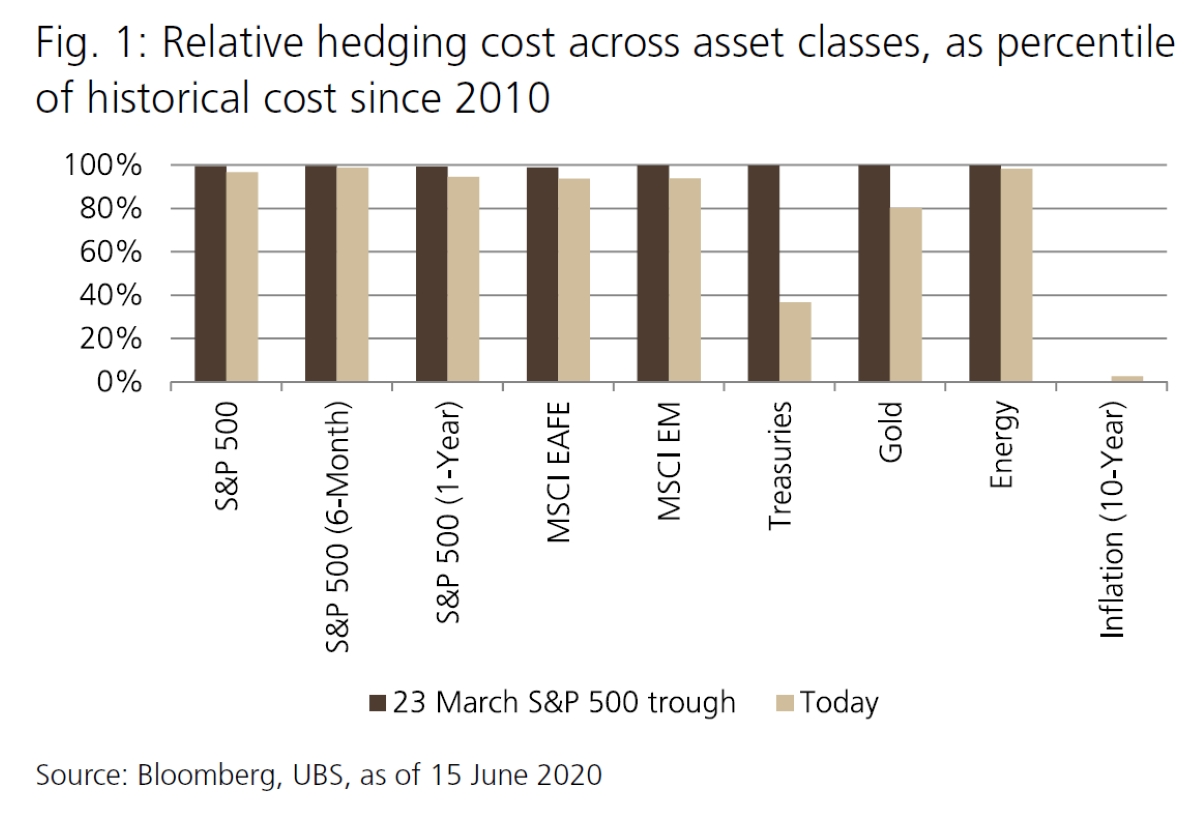

Finance
What Is Fuel Hedging
Published: January 15, 2024
Discover the concept of fuel hedging in finance and how it can mitigate risks associated with volatile fuel prices. Learn more about this strategic financial tool.
(Many of the links in this article redirect to a specific reviewed product. Your purchase of these products through affiliate links helps to generate commission for LiveWell, at no extra cost. Learn more)
Table of Contents
- Introduction
- Definition of Fuel Hedging
- Reasons for Fuel Hedging
- The Role of Fuel Prices in the Aviation Industry
- Types of Fuel Hedging Instruments
- Benefits and Risks of Fuel Hedging
- Case Studies of Successful Fuel Hedging Strategies
- Factors to Consider in Implementing Fuel Hedging
- Future Trends in Fuel Hedging
- Conclusion
Introduction
In the unpredictable world of finance, risk management is crucial for businesses to protect themselves against unforeseen events and fluctuations. One area where risk management plays a vital role is in the aviation industry, particularly when it comes to fuel prices.
Fuel prices are a significant expense for airlines, often representing one of the largest costs in their operations. However, the volatile nature of the fuel market can present challenges for airlines, as prices can fluctuate dramatically due to geopolitical factors, economic conditions, and supply and demand dynamics.
To mitigate these risks and protect their bottom line, airlines employ a strategy known as fuel hedging. Fuel hedging is the practice of locking in fuel prices at a certain level by entering into derivative contracts, such as futures or options, to offset potential losses or gains resulting from fluctuations in fuel prices.
By employing fuel hedging strategies, airlines aim to stabilize their fuel costs and gain a level of predictability in their financial planning. This allows them to better manage their expenses, improve budgeting accuracy, and potentially gain a competitive advantage in the highly competitive aviation industry.
In this article, we will explore the concept of fuel hedging in more detail, including its definition, reasons for implementation, the role of fuel prices in the aviation industry, types of fuel hedging instruments, benefits and risks associated with fuel hedging, case studies of successful fuel hedging strategies, factors to consider when implementing fuel hedging, and future trends in fuel hedging.
By understanding the intricacies of fuel hedging, businesses in the aviation industry can make informed decisions to protect their financial health and navigate the challenges of fluctuating fuel prices.
Definition of Fuel Hedging
Fuel hedging is a risk management strategy used by businesses, particularly those in the aviation industry, to mitigate the financial risks associated with fluctuations in fuel prices. It involves entering into financial contracts or derivatives, such as futures, options, or swaps, to fix the price of fuel or establish a price range within which the business can purchase fuel in the future.
Essentially, fuel hedging allows businesses to protect themselves against unexpected increases in fuel prices by locking in a predetermined price for a certain volume of fuel. By doing so, they can ensure a certain level of stability in their fuel costs, regardless of market fluctuations.
The primary objective of fuel hedging is to reduce uncertainty and provide some level of predictability in budgeting and financial planning. By fixing fuel prices in advance, businesses can accurately forecast their expenses and better manage their cash flow.
It is important to note that fuel hedging is not a speculative activity; rather, it is a risk management tool. The intention is not to make a profit from predicting fuel price movements, but rather to protect against the potential losses that could result from significant price fluctuations.
To implement fuel hedging, businesses typically work with financial institutions or specialized brokers who facilitate the execution of derivative contracts. These contracts allow businesses to establish a fixed price or price range for a specified volume of fuel, with settlement typically occurring at a future predetermined date.
In the aviation industry, fuel hedging is particularly prevalent due to the high fuel costs incurred by airlines. By employing fuel hedging strategies, airlines can better manage their expenses, improve their financial stability, and potentially gain a competitive advantage in a highly competitive market.
Overall, fuel hedging is a risk management strategy that allows businesses to take control of fuel costs and protect themselves from unforeseen price fluctuations. It provides businesses with a level of stability and predictability in their financial planning, ultimately contributing to their long-term financial health and success.
Reasons for Fuel Hedging
The implementation of fuel hedging strategies is driven by several key reasons that highlight the importance of managing fuel price risk for businesses in the aviation industry.
1. Mitigating Price Volatility: Fuel prices are notorious for their volatility, which can significantly impact the financial performance of airlines. By implementing fuel hedging, airlines can protect themselves against sudden and unpredictable increases in fuel prices. This allows them to maintain more stable operating costs and avoid potential financial hardship during periods of price spikes.
2. Budgeting and Financial Planning: Fuel is one of the largest expenses for airlines, and its cost directly affects their profitability. Fuel hedging provides airlines with greater visibility and certainty in their budgeting and financial planning. By fixing or establishing a price range for fuel through hedging instruments, airlines can accurately forecast their fuel costs and make informed decisions regarding fleet expansion, route planning, and pricing strategies.
3. Stability in Pricing: By hedging fuel prices, airlines can lock in a certain price for a predetermined volume of fuel. This stability in pricing allows airlines to offer more consistent airfares to passengers, enhancing customer satisfaction and loyalty. It also helps airlines maintain a competitive edge in the market by avoiding abrupt fare increases due to sudden spikes in fuel prices.
4. Long-Term Contracts: Airlines typically enter into long-term contracts with fuel suppliers to ensure a steady supply of fuel. However, these contracts often lack price protection and expose airlines to market price fluctuations. Fuel hedging enables airlines to align their long-term supply contracts with fixed or predetermined fuel prices, reducing the risk of significant price increases and providing a stable cost structure.
5. Financial Stability and Risk Management: Fuel hedging plays a crucial role in enhancing the financial stability of airlines. By managing fuel price risk, airlines can minimize the impact of fuel price fluctuations on their bottom line and improve their overall financial performance. This allows airlines to build stronger balance sheets, attract investors, and maintain a stable credit rating.
6. Competitive Advantage: Airlines that effectively implement fuel hedging strategies can gain a competitive advantage over their peers. By mitigating fuel price risk, airlines have greater control over their operating costs, enabling them to offer more competitive airfares or invest in additional services and amenities for their passengers.
In summary, the reasons for implementing fuel hedging strategies in the aviation industry include mitigating price volatility, improving budgeting and financial planning, ensuring stability in pricing, aligning long-term contracts with fixed prices, enhancing financial stability and risk management, and gaining a competitive advantage. Fuel hedging provides businesses with the tools to navigate the uncertainties of the fuel market, protect their profitability, and achieve long-term success in a highly competitive industry.
The Role of Fuel Prices in the Aviation Industry
Fuel prices play a critical role in the aviation industry, impacting the operational costs, profitability, and overall performance of airlines. Here are some key aspects that highlight the significance of fuel prices in the aviation industry:
1. Cost Factor: Fuel expenses consistently rank as one of the largest costs for airlines. In fact, fuel can account for up to 25-30% of an airline’s operating expenses. Any fluctuations in fuel prices can have a direct and substantial impact on an airline’s cost structure and profitability.
2. Volatility: Fuel prices are notoriously volatile, influenced by various factors such as geopolitical events, economic conditions, supply and demand dynamics, and market speculation. The unpredictable nature of fuel price movements presents a significant challenge for airlines, making it difficult to accurately forecast and manage their expenses.
3. Price Pass-Through: The impact of fuel price fluctuations is not absorbed solely by airlines but is often passed on to passengers through fare adjustments. When fuel prices rise, airlines may increase ticket prices to maintain profitability. Conversely, when fuel prices decrease, airlines may pass on the savings to passengers through lower fares. This dynamic relationship between fuel prices and airfares directly affects consumer demand and the financial performance of airlines.
4. Competitiveness: Fuel prices also play a role in determining the competitive landscape within the aviation industry. Airlines that can mitigate the impact of rising fuel prices or efficiently manage their fuel costs through strategies like fuel hedging have a competitive advantage. They can offer more attractive airfares, invest in new routes, enhance services, or withstand tough market conditions.
5. Capacity Planning: Fuel prices influence airlines’ decisions regarding fleet size and capacity planning. High fuel prices can incentivize airlines to adopt fuel-efficient aircraft or reduce flight frequencies to optimize fuel consumption. Similarly, lower fuel prices may encourage airlines to expand their operations and increase capacity.
6. Environmental Impact: Fuel prices also have implications for the environmental sustainability of the aviation industry. Rising fuel prices can drive airlines to invest in more fuel-efficient aircraft, alternative fuels, and sustainable practices to reduce their carbon footprint and comply with environmental regulations.
In summary, fuel prices are a critical factor in the aviation industry, impacting airline costs, profitability, competitive positioning, capacity planning, consumer fares, and environmental sustainability. The volatility of fuel prices creates challenges for airlines, making effective fuel management strategies essential for financial stability and long-term success in the ever-evolving aviation landscape.
Types of Fuel Hedging Instruments
There are various types of fuel hedging instruments available for businesses in the aviation industry to manage their fuel price risk. These instruments allow airlines to establish price protection, fix future fuel prices, or limit the potential losses resulting from fuel price fluctuations. Here are the common types of fuel hedging instruments:
1. Futures Contracts: Futures contracts are one of the most commonly used fuel hedging instruments. These contracts specify the purchase or sale of a specific quantity of fuel at a predetermined price on a future date. Airlines can enter into futures contracts to lock in the price of fuel, ensuring a predictable cost structure for their operations.
2. Options Contracts: Options contracts provide airlines with the right, but not the obligation, to buy or sell fuel at a specific price within a specified period. Call options give the holder the right to buy fuel, while put options give the holder the right to sell fuel. Options contracts offer flexibility to airlines, allowing them to benefit from favorable fuel price movements while limiting potential losses.
3. Swaps: Fuel swaps involve two parties exchanging cash flows based on the difference between a fixed price and a floating market price of fuel. One party pays the other party based on the direction of fuel price movements. Swaps allow airlines to effectively manage fuel price risk by fixing the difference between the current market price and the desired price for a specific volume of fuel.
4. Collars: Collars are a combination of options contracts that establish a price range within which airlines can buy or sell fuel. A collar consists of buying a put option to establish a price floor and selling a call option to establish a price ceiling. This allows airlines to protect themselves against both significant increases and decreases in fuel prices while maintaining a certain level of price stability.
5. Fuel Hedging Consultants/Brokers: Airlines may also seek assistance from third-party consultants or brokers specializing in fuel hedging strategies. These professionals provide expertise in analyzing fuel price trends, developing hedging strategies, and executing derivative contracts on behalf of airlines. They help airlines navigate the complexities of fuel hedging and optimize their risk management strategies.
It’s important to note that the choice of fuel hedging instrument depends on various factors, including the airline’s risk tolerance, market conditions, and hedging objectives. Each instrument has its advantages and considerations, and airlines must assess their specific needs and consult with experts to determine the most suitable combination of fuel hedging instruments.
By utilizing these various types of fuel hedging instruments, businesses in the aviation industry can effectively manage their fuel price risk and maintain financial stability in the face of unpredictable fuel market conditions.
Benefits and Risks of Fuel Hedging
Fuel hedging offers several benefits for businesses in the aviation industry, but it also comes with certain risks. Understanding these benefits and risks is crucial for making informed decisions regarding fuel hedging strategies. Here’s a closer look at the benefits and risks of fuel hedging:
Benefits:
- Price Stability: One of the primary benefits of fuel hedging is price stability. By locking in future fuel prices or establishing price ranges, airlines can mitigate the impact of fuel price fluctuations, resulting in more stable and predictable operating costs.
- Budgeting and Planning: Fuel hedging provides greater visibility and accuracy in budgeting and financial planning. Airlines can forecast fuel expenses more accurately and make informed decisions regarding pricing, capacity, and route planning.
- Competitive Advantage: Effective fuel hedging strategies can give airlines a competitive advantage. By managing fuel costs, airlines can offer more competitive fares, invest in innovative services, or withstand tough market conditions, enhancing their market position and profitability.
- Risk Reduction: Fuel hedging allows airlines to reduce their exposure to fuel price volatility. This risk reduction helps airlines protect their financial health and avoid potential losses resulting from significant fuel price fluctuations.
- Financial Stability: Fuel hedging contributes to overall financial stability for airlines. By managing fuel price risk, airlines can improve their balance sheets, attract investors, and maintain a stable credit rating.
Risks:
- Incorrect Market Timing: One of the primary risks of fuel hedging is incorrect market timing. If airlines enter into hedging contracts when fuel prices are already low, they may miss out on potential cost savings. Conversely, entering into contracts when prices are high may lead to higher expenses.
- Price Speculation: While fuel hedging is a risk management strategy, there is a risk of inadvertently engaging in price speculation. If airlines enter into excessive hedges or speculative positions, they may expose themselves to potential losses if fuel prices move in the opposite direction.
- Contractual Obligations: Hedging contracts are legally binding agreements, and airlines must fulfill their contractual obligations. If fuel prices decline significantly below the contracted price, airlines may be locked into higher prices, potentially incurring financial losses.
- Lack of Flexibility: Hedging contracts can restrict airlines’ flexibility to take advantage of favorable market conditions. If fuel prices decrease significantly, airlines with hedging contracts may be unable to benefit from the savings and may have to honor their contractual obligations.
- Opportunity Cost: When airlines allocate financial resources to fuel hedging, there is an opportunity cost involved. The funds tied up in hedging contracts could have been utilized for other investments or operational needs, potentially impacting the overall financial performance of the airline.
It’s important for airlines to carefully assess the benefits and risks of fuel hedging and develop a comprehensive risk management strategy. This involves understanding market dynamics, monitoring fuel price trends, and consulting with experts to navigate the complexities of fuel hedging effectively.
By implementing fuel hedging strategies while being aware of the potential risks, airlines can better manage their fuel price risk, improve financial stability, and enhance their competitive position in the aviation industry.
Case Studies of Successful Fuel Hedging Strategies
Several airlines have demonstrated the effectiveness of fuel hedging strategies in managing fuel price risk and achieving financial success. Here are a few prominent case studies showcasing successful fuel hedging strategies:
1. Southwest Airlines: Southwest Airlines is known for its successful fuel hedging strategy, which has played a significant role in its financial performance. The airline consistently hedges a significant portion of its fuel consumption, allowing it to mitigate the impact of fuel price fluctuations. In the past, Southwest Airlines’ fuel hedging strategies have resulted in substantial cost savings, contributing to its profitability and competitive advantage.
2. Delta Air Lines: Delta Air Lines has also implemented successful fuel hedging strategies. In one case, the airline locked in fuel prices through hedging contracts at a time when fuel prices were high. This strategy proved beneficial when fuel prices subsequently declined. Delta was able to save millions on fuel costs, enhancing its financial position and allowing for investments in customer experience improvements and fleet upgrades.
3. AirAsia: AirAsia, a low-cost carrier based in Asia, has successfully utilized fuel hedging to manage its fuel price risk. The airline adopted a hedging program whereby it locked in fuel prices for a portion of its future fuel consumption. This proactive approach has allowed AirAsia to maintain a stable cost structure and offer competitive airfares, contributing to its growth and profitability in the highly price-sensitive market.
4. Emirates: Emirates, one of the world’s largest international airlines, has implemented a diversified fuel hedging strategy. The airline utilizes a combination of financial instruments such as futures, options, and swaps to manage its fuel price exposure. By employing this comprehensive approach to fuel hedging, Emirates has been able to reduce its vulnerability to fuel price fluctuations and effectively control its fuel costs.
These case studies highlight the importance of strategic fuel hedging and its positive impact on the financial performance of airlines. Successful implementation of fuel hedging strategies allows airlines to stabilize their fuel costs, protect against market volatility, and achieve a competitive advantage in the industry.
It’s worth noting that each airline’s fuel hedging strategy is tailored to its specific needs and risk appetite. Factors such as market conditions, financial resources, and risk management objectives influence the design and implementation of fuel hedging strategies.
Overall, these case studies demonstrate that a well-executed fuel hedging strategy can contribute significantly to an airline’s financial success, providing stability, cost savings, and a competitive edge in the dynamic aviation industry.
Factors to Consider in Implementing Fuel Hedging
Implementing a successful fuel hedging strategy requires careful consideration of various factors that can impact the effectiveness and outcomes of the hedging program. Here are some key factors to consider when implementing fuel hedging:
1. Risk Management Objectives: Define the risk management objectives of the fuel hedging strategy. Determine the level of risk tolerance, desired price stability, and financial goals of the organization. Clearly identify the purpose and expected outcomes of the hedging program to align it with the overall business strategy.
2. Market Analysis: Conduct a thorough analysis of fuel market trends, supply and demand dynamics, geopolitical factors, and industry forecasts. This analysis will provide insights into fuel price volatility, market conditions, and potential risks, allowing for more informed decisions and the development of an effective hedging strategy.
3. Financial Resources: Assess the financial resources available for fuel hedging. Determine the budget allocated for hedging activities, taking into account potential margin calls and collateral requirements. Adequate financial resources are essential to support the hedging program and maintain contractual obligations.
4. Risk Profile Assessment: Evaluate the specific risk exposures of the business related to fuel price fluctuations. Consider factors such as the proportion of fuel costs in the overall operating expenses, the volatility of fuel prices, and the impact of price changes on profitability. This assessment will help determine the appropriate hedging instruments and strategies to mitigate risks effectively.
5. Knowledge and Expertise: Develop a deep understanding of fuel markets and hedging instruments or seek assistance from specialized advisors or consultants with expertise in fuel hedging. It is essential to have knowledgeable staff or external experts who can effectively analyze market data, assess risk exposures, and execute hedging transactions.
6. Hedging Instruments Selection: Select the appropriate fuel hedging instruments based on the organization’s risk management objectives, risk appetite, and market analysis. Consider the advantages and limitations of each instrument, such as futures contracts, options contracts, or swaps, and determine the optimal combination that aligns with the organization’s hedging goals.
7. Execution and Monitoring: Develop a well-defined process for the execution and monitoring of hedges. This includes establishing clear guidelines for entering into hedging contracts, monitoring the effectiveness of hedges, and periodically reviewing and adjusting the hedging strategy based on changing market conditions or business objectives.
8. Regulatory Considerations: Stay informed about regulatory requirements and accounting standards related to fuel hedging activities. Comply with applicable regulations and ensure transparency and accuracy in reporting fuel hedging activities in financial statements.
9. Continuous Learning and Adaptation: The fuel market and risk management landscape evolve over time. It is crucial to continuously learn, adapt, and refine the fuel hedging strategy based on lessons learned, industry developments, and market dynamics. Regularly reassess the effectiveness of the hedging program and make adjustments as needed.
By carefully considering these factors, organizations can develop and implement effective fuel hedging strategies that align with their risk management objectives, protect against fuel price volatility, and contribute to long-term financial stability and success.
Future Trends in Fuel Hedging
Fuel hedging practices continue to evolve as the aviation industry adapts to changing market dynamics and seeks innovative approaches to manage fuel price risk. Here are some key future trends in fuel hedging:
1. Enhanced Risk Management Tools: Advances in technology and data analytics are providing new opportunities for more sophisticated risk management tools. The use of artificial intelligence, machine learning, and predictive modeling can help airlines better analyze fuel market trends, optimize hedging strategies, and make data-driven decisions to manage fuel price risk effectively.
2. Sustainability Considerations: With increasing focus on environmental sustainability, future fuel hedging strategies are likely to include considerations for sustainable aviation fuels (SAF) and carbon credits. Airlines may explore hedging instruments specifically designed for SAF prices or implement carbon offset programs to manage their carbon footprint while hedging against fuel price volatility.
3. Collaboration and Partnerships: Airlines may seek to collaborate and form partnerships with fuel suppliers, other airlines, or even financial institutions to create innovative fuel hedging solutions. By pooling resources and knowledge, airlines can enhance their bargaining power and access more tailored and efficient fuel hedging instruments.
4. Flexible Hedging Approaches: Future fuel hedging strategies may involve more flexible approaches to adapt to ongoing market changes. Airlines may employ dynamic hedging, where contracts are adjusted or rolled over periodically based on the prevailing market conditions rather than fixed contract durations. This flexibility allows for better alignment with shifting fuel price trends and market fluctuations.
5. Integrated Risk Management: Fuel hedging is just one aspect of comprehensive risk management. In the future, there may be a trend toward integrated risk management frameworks that encompass all aspects of airline operations. This approach would integrate fuel hedging with other risk management strategies, such as foreign exchange risk, interest rate risk, and operational risk, to optimize overall risk mitigation and financial performance.
6. Regulatory Changes: Regulatory changes, including potential carbon pricing mechanisms or emissions trading schemes, can impact the fuel hedging landscape. Airlines must stay informed about evolving regulations and adapt their hedging strategies accordingly to align with sustainability goals and comply with regulatory requirements.
7. Focus on Cost Efficiency: As airlines strive for cost efficiency in a competitive market, future fuel hedging strategies may prioritize cost optimization. This can include careful selection of hedging instruments, benchmarking against industry best practices, and exploring innovative hedging techniques to achieve the most favorable cost structure and financial outcomes.
8. Risk Mitigation Beyond Fuel: While fuel hedging primarily focuses on managing fuel price risk, future trends may incorporate broader risk mitigation strategies. Airlines may explore ways to hedge against other factors that impact fuel costs, such as currency exchange rates or geopolitical risks, to further enhance financial stability and reduce overall risk exposure.
As the aviation industry continues to evolve, fuel hedging strategies will adapt to address emerging challenges and opportunities. Future trends in fuel hedging will likely involve a combination of technological advancements, sustainability considerations, collaborative efforts, and a broader integrated risk management approach. By staying agile and proactive, airlines can navigate the complexities of fuel markets and minimize their exposure to fuel price volatility, ultimately enhancing their financial performance and resilience in a rapidly changing industry.
Conclusion
Fuel hedging has become an essential risk management strategy for businesses in the aviation industry, allowing them to mitigate the financial risks associated with fuel price fluctuations. By employing various fuel hedging instruments, airlines can stabilize their fuel costs, improve budgeting accuracy, and gain a competitive advantage in the market.
The benefits of fuel hedging are well-documented, including price stability, improved financial planning, enhanced competitiveness, risk reduction, and overall financial stability. Case studies of successful fuel hedging strategies from airlines like Southwest Airlines, Delta Air Lines, AirAsia, and Emirates highlight the positive impact that effective fuel hedging can have on an airline’s profitability and growth.
However, it’s crucial to consider the risks associated with fuel hedging, such as incorrect market timing, contractual obligations, lack of flexibility, and opportunity cost. Careful assessment of market conditions, risk profiles, and financial resources is necessary to develop a comprehensive and effective fuel hedging strategy.
Looking ahead, future trends in fuel hedging include advancements in risk management tools, sustainability considerations, collaboration and partnerships, flexible hedging approaches, integrated risk management, regulatory changes, a focus on cost efficiency, and risk mitigation beyond fuel alone.
As the aviation industry continues to evolve, fuel hedging strategies must adapt to meet the challenges and opportunities of a rapidly changing market. By staying informed, leveraging technology, and embracing innovative approaches, businesses can navigate the complexities of fuel price volatility and enhance their financial performance and resilience.
In conclusion, fuel hedging is a crucial tool for managing fuel price risk in the aviation industry. With proper planning, analysis, and execution, fuel hedging can provide stability, protect profitability, and contribute to the long-term success of businesses in the dynamic and competitive aviation landscape.














